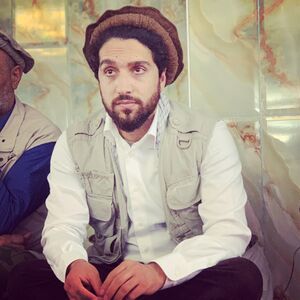Ahmad Shah Massoud
( military, politician) | |
|---|---|
 | |
| Born | 2 September 1953 |
| Died | 9 September 2001 (Age 48) |
Cause of death | |
| Nationality | Afghan |
| Victim of | |
Ahmad Massoud.jpg | |
Ahmad Shah Massoud was an Afghan politician and military commander who was assassinated two days before 11/9]] in what might have been a precondition and 'green light' both for the event as well as for the invasion of Afghanistan a few months later[1].
History
Massoud was a powerful and prominent guerrilla commander during the resistance against the Afghan government and Soviet forces between 1979 and 1989. In the 1990s, he fought against rival militias and, after the Taliban takeover, was the leading opposition commander against their regime until his assassination in 2001.
Assassination
In late 2000 al-Qaeda and the Taliban (both with links to Pakistani intelligence, the ISI) had reached an agreement to eliminate Massoud, Pakistan’s chief enemy[2]. By this time Massoud—“thought to be Afghanistan’s greatest guerrilla fighter”—was the only resistance leader “left to fight on against the Taliban militia.”
Massoud was the target of an assassination plot in northeastern Afghanistan on September 9, 2001. The attackers' names were alternately given as Dahmane Abd al-Sattar, husband of Malika El Aroud, and Bouraoui el-Ouaer; or 34-year-old Karim Touzani and 26-year-old Kacem Bakkali.
The attackers claimed to be Belgians originally from Morocco. According to Le Monde they transited through the municipality of Molenbeek. Their passports turned out to be stolen and their nationality was later determined to be Tunisian.[3]
The attackers, masquerading as journalists, used an introduction letter to gain access to Massoud’s heavily guarded headquarters in the Panjshir Valley. The letter was drafted by telephone by Ahmed Abdel Sattar and Yassir al-Sirri, an Egyptian terrorist and refugee in London. It is unclear how much the US government knew of the letter.
Waiting for almost three weeks for an interview opportunity, on September 8, 2001, an aide to Massoud recalls the would-be suicide attackers "were so worried" and threatened to leave if the interview did not happen in the next 24 hours (until September 10, 2001). They were finally granted an interview. During the interview, they set off a bomb composed of explosives hidden in the camera and in a battery-pack belt. Commander Massoud died in a helicopter that was taking him to an Indian military field hospital at Farkhor in nearby Tajikistan. The explosion also killed Mohammed Asim Suhail, a United Front official, while Mohammad Fahim Dashty and Massoud Khalili were injured. One of the suicide attackers, Bouraoui, was killed by the explosion, while Dahmane Abd al-Sattar was captured and shot while trying to escape.
British and U.S. legal responses to the letter of introduction, though different, attest to the importance they paid to it. In October 2001, the British arrested al-Sirri in connection with Massoud’s murder, but “Inexplicably, a British judge later cleared al-Sirri of all charges and released him, labeling him ‘an innocent fall guy.’”[4] Meanwhile, on April 9, 2002, one month before the Times news story about him, the United States indicted both al-Sirri and Sattar, along with Lynne Stewart, the Brooklyn attorney who represented the blind sheikh and allegedly passed messages for him. But the U.S. indictment said nothing about the lethal letter of introduction, which was never mentioned again in the U.S. press.[5]
Massoud had survived assassination attempts over a period of 26 years, including attempts made by al-Qaeda, the Taliban, the Pakistani ISI and before them the Soviet KGB, the Afghan communist KHAD and Hekmatyar. The first attempt on Massoud's life was carried out by Hekmatyar and two Pakistani ISI agents in 1975 when Massoud was 22 years old. In early 2001, al-Qaeda would-be assassins were captured by Massoud's forces while trying to enter his territory.[6]
Against foreign forces
The U.S. plans to invade landlocked Afghanistan, dating from as early as July 2001, depended on using as their base Massoud’s territory in the impenetrable Panjshir Valley, the only Afghan region never overrun by the Taliban. They also depended on using the territory of America’s regional ally Pakistan. Massoud and Pakistan, however, were implacable enemies. More importantly, though Massoud welcomed U.S. military support, he was bitterly opposed to the idea of a U.S. invasion. His death and the following break-up of he coallition ensured that, instead of Americans supporting an indigenous military campaign against the Taliban, the separate warlords—each with a very checkered background—would now be assisting an American campaign.
References
- ↑ https://covertactionmagazine.com/2020/12/09/was-the-now-forgotten-murder-of-one-man-on-september-9-2001-a-crucial-pre-condition-for-9-11/
- ↑ https://www.aljazeera.com/opinions/2014/9/9/afghanistan-in-the-shadow-of-ahmad-shah-massoud/
- ↑ http://www.lemonde.fr/europe/article/2015/11/16/molenbeek-la-plaque-tournante-belge-du-terrorisme-islamiste_4810617_3214.html
- ↑ https://www.nytimes.com/2002/08/10/world/british-court-frees-a-muslim-arrested-after-9-11.html
- ↑ https://covertactionmagazine.com/2020/12/09/was-the-now-forgotten-murder-of-one-man-on-september-9-2001-a-crucial-pre-condition-for-9-11/#_ftn19
- ↑ Roy Gutman. How We Missed the Story: Osama Bin Laden, the Taliban and the Hijacking of AfghanistanI/i> (1st ed., 2008 ed.). Endowment of the United States Institute of Peace, Washington DC. p. 34